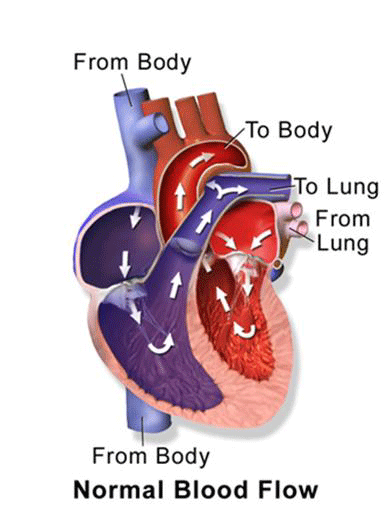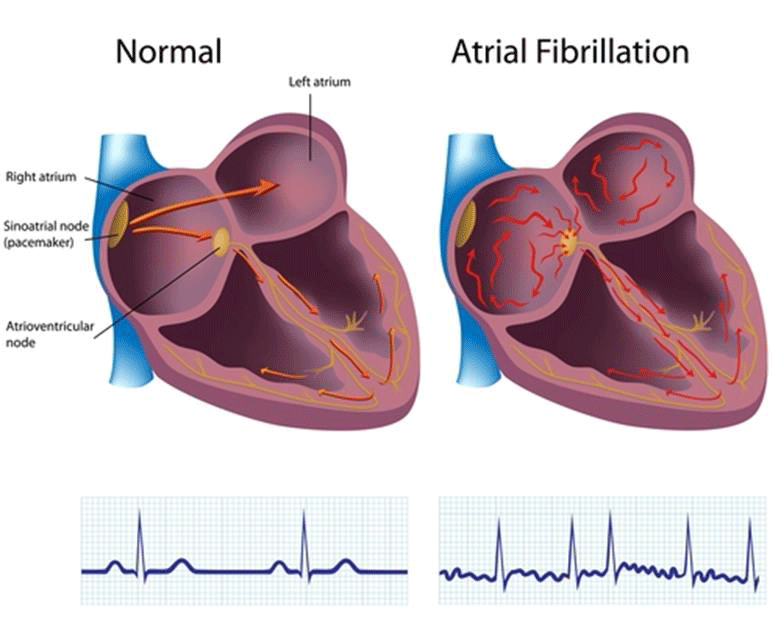


Joseph R. Anticaglia MD
Medical Advisory Board
Atrial fibrillation, also known as AFib or AF, often causes the heart to beat faster with an abnormal rhythm. It is the most common chronic, irregular heart rhythm in the U. S. It strikes more than two and half million people in America and the incidence of AFib rises with age. It’s most prevalent in people over the age of 65 affecting about nine per cent of this population; and there isn’t a predictable pattern to the irregular heart rhythm (arrhythmia).
The heart has four separate chambers, two on the right side and two on the left side. This muscular organ’s two upper chambers are the atria. The two lower chambers are the ventricles. The ventricles are the main force that propels blood throughout the body. Under normal conditions, the two chambers work together to make the heart work most effectively in pumping blood to the body and to the lungs.

When the upper atrial chambers are out of sync with the lower ventricular chambers, the ventricles do not fill completely with blood and the heart doesn’t pump enough blood to the lungs nor to the rest of the body. The ventricles can pool with blood, form clots and precipitate a stroke.
When the heart is malfunctioning, as noted above, people have complained of being terribly fatigued, dizzy, lightheaded and feeling as if they are about to faint. Others have complained of heart palpitations or chest pain. Ironically, some individuals with AFib have no complaints. And at times, atrial fibrillation disappears on its own without a good explanation.
Richard is a 63 year old retired fireman who routinely walked three miles per day rain or shine. Richard complained of being tired, lightheaded and unable to perform his daily walks. When asked about his symptoms, he told his doctor:
“I don’t have chest pain or palpitations. I just feel real tired, light headed and as if I’m going to faint and hit the ground. In fact, it happened twice when I suddenly felt lightheaded and dropped to the ground. I didn’t pass out and when I got up I felt fine. I now have trouble walking up a few flights of steps and walking on a street with a steep incline.”
His physician performed an electrocardiogram and the findings indicated that he had atrial fibrillation. Even though Richard had no subjective complaints referable to the heart, silent AFib, his doctor placed him on medications to control AFib.
His doctor said, “The reasons I want you to take these medications are to prevent a stroke, to slow down the heart rate, get the heart rate back to a normal rhythm and to relieve your symptoms. With these medications you should be less tired and not feel lightheaded.” The doctor next showed Richard his electrocardiogram.
An electrocardiogram, abbreviated EKG or ECG, records the electrical activity of the heart. The heart’s natural electrical system begins in the right atrium with the sinoatrial node (SA node) which regulates the beat of the heart. It sends impulses from the top of the heart (upper chambers or atria) downward to the bottom of the heart (the lower chambers or ventricles) and eventually to special fibers that cause the ventricles to contract.
A healthy heart beats at a regular rate between 60 to 100 beats per minute and with a regular heart pattern (rhythm). With atrial fibrillation the heart beats faster than normal and the normal heart pattern is disrupted.

Some people have atrial fibrillation for no reason. Others may have AFib that goes away for no reason. Others may have AFib that comes and goes called paroxysmal (abrupt onset of) atrial fibrillation. Paroxysmal AFib may be due to coronary heart disease, hypertension or diseases of the heart muscle or heart valves.
If left untreated, paroxysmal AFib may develop into permanent atrial fibrillation. Permanent AFib is serious but treatable. Other causes of atrial fibrillation are blood clot in the lung (pulmonary embolism), alcohol and certain medications can cause AFib such as albuterol or theophylline which are bronchodilators used to treat asthma and other lung conditions.
It was the Sunday morning of the July 4th weekend that Daniel was rushed to the emergency room complaining of being out of breath, feeling dizzy and having chest pain. This 31 year old salesman was in excellent health until the July 4th episode. He admitted to “binge drinking” the night before being rushed to the E. R.
The E. R. physician took Daniel’s medical history, listened to his heart which was beating faster than normal and an electrocardiogram indicated that he had atrial fibrillation. He was admitted to the hospital for observation and his heart rate and heart rhythm returned to within a normal range. Daniel was advised about the adverse relationship of binge drinking and heart problems. In predisposed individuals, even a small amount of alcohol can trigger AFib,
In 1978, Philip Ettinger first described the association of the consumption of an excessive amount of alcohol in a short period of time and cardiac arrhythmias in persons without heart disease. He labeled it Holiday Heart Syndrome since he observed it more frequently after public holidays.
There are times when medications do not work to control atrial fibrillation or a person may experience serious side effects from those drugs. In these instances, successful cardiac ablation has been a life changing experience.
Karen, a 73 year old retired school teacher, had terrible side effects from medications prescribed for her atrial fibrillation. Karen’s doctor, an electrophysiologist, reviewed her medical history, his findings and recommended cardiac ablation.
He said, “Electrical impulses in the top of the heart, the right atrium, were misfiring and preventing the heart from contracting normally. Cardiac ablation corrects the abnormal heart rhythm by allowing the heart to contract normally.
“I plan to insert a catheter, a long flexible tube, in the vein in your groin and pass it up to your heart. Once in the right side of the heart, the right atrium, I will destroy the tissue that’s causing the irregular heart rhythm.”
Karen was discharged from the hospital the next morning and when she returned for a follow up visit she simply said, “I feel great! And I don’t have to take any medications.”
The goals of treatment are to:
Atrial fibrillation is a common problem and the incidence is expected to become more prevalent because of the aging population. Presently, there are good options to treat and control this condition.
This article is intended solely as a learning experience. Please consult your physician for diagnostic and treatment options.